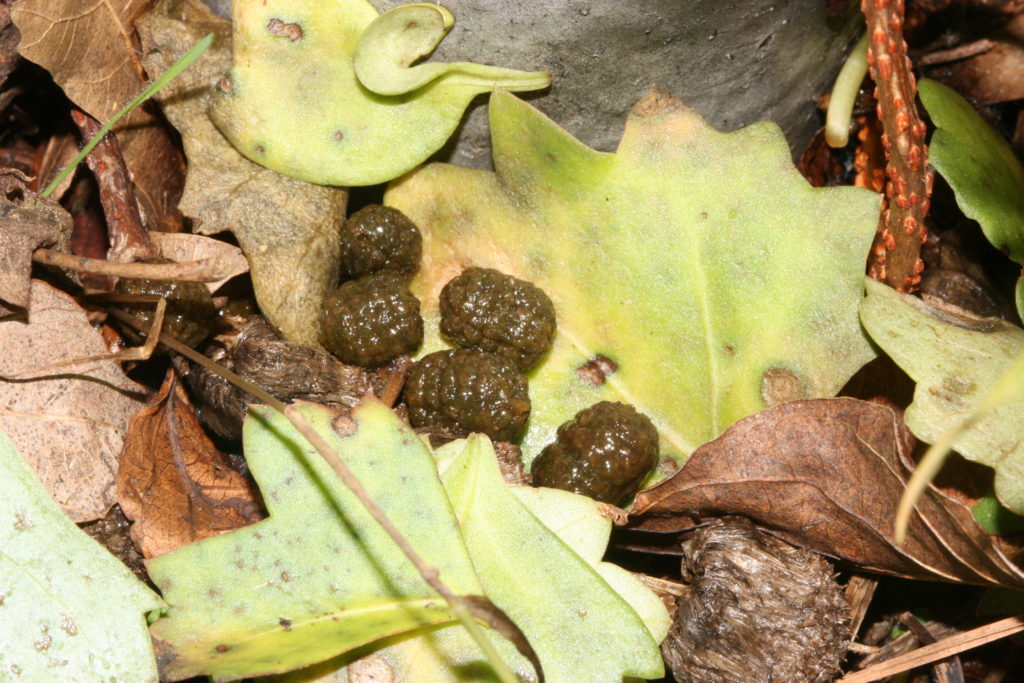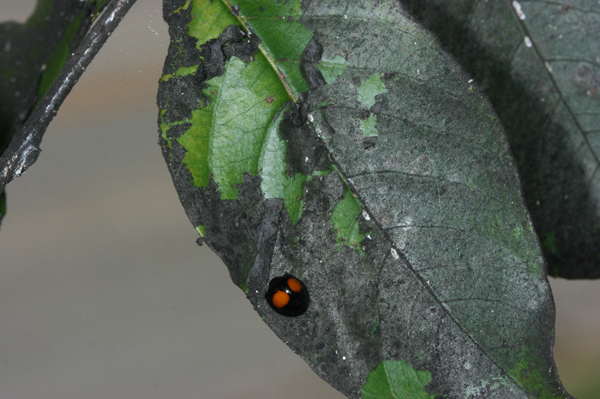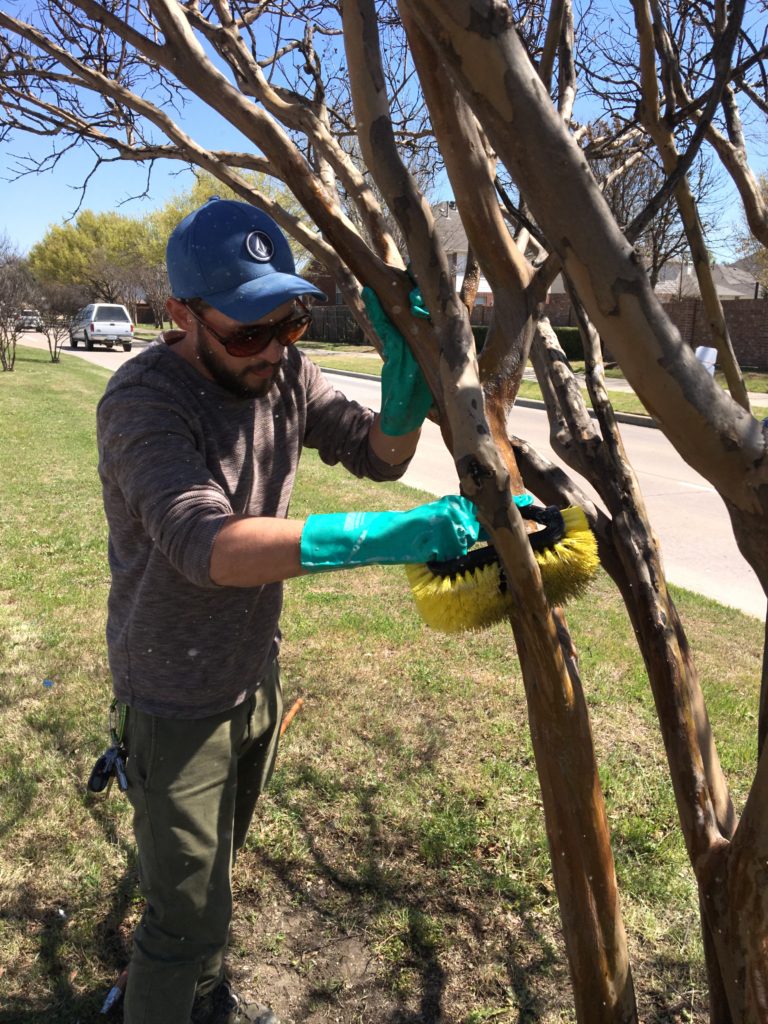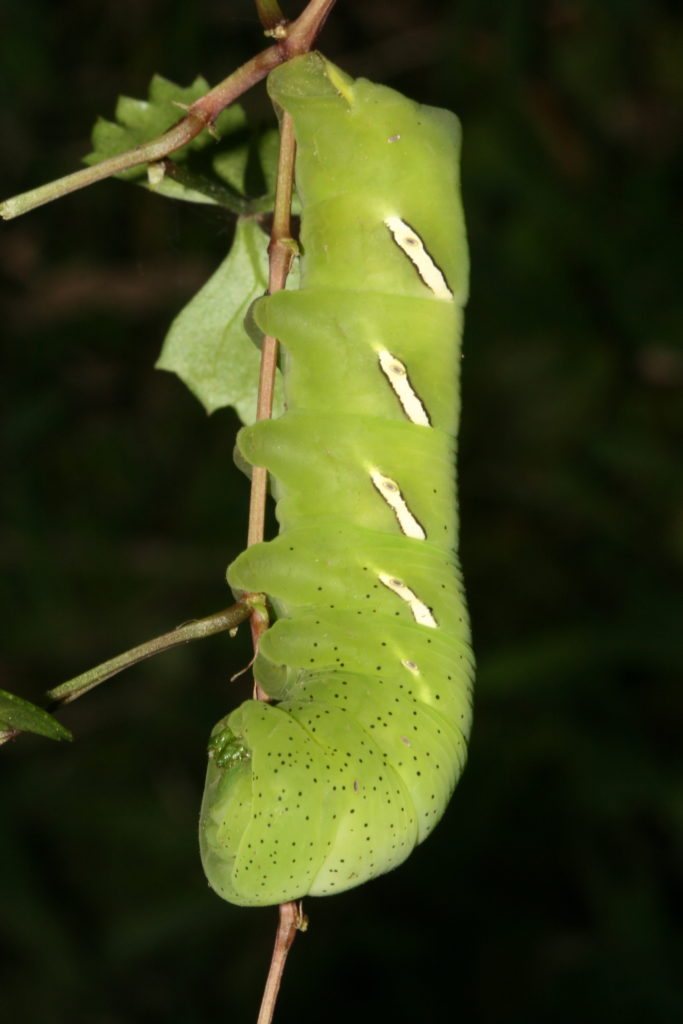Never estimate how low this blog can go in the search for article ideas. After listening to some internet chatter today on the subject of cleaning black mold off of trees, I thought someone else might be interested in the dark side of insect poop. Feel free to close your browser now if I was wrong.
Before anything else, let’s clear the air about insect poop. Most insect poop is inconsequential, harmless and rarely noticed by the home gardener. The exception might be those caterpillars that leave poop big enough to be noticed. In fact, one of the best ways to check your plants for caterpillar feeding is to look for the fluffy “poop pills” they leave behind. This scouting tip works because caterpillar poop is generally darker in color and sits mostly on tops of the leaves, compared to the devilishly camouflaged caterpillars themselves.

Pandorus sphinx moth caterpillar feces are sometimes more easy to see than the camouflaged caterpillar.
Insect poop really only becomes a problem to a gardener (and the plant) when it’s in liquid form. Liquid poop is called honeydew and it is excreted by insects feeding on the sugar-rich plant sap called phloem. Examples of sap-feeding insects that produce honeydew include aphids, some scale insects, mealybugs, whiteflies and some kinds of galls.
Honeydew
Honeydew is what remains of the processed plant sap that is expelled from the insect’s anus. Far from being depleted of nutrition, honeydew retains up to 90% of the original plant sugars from the sap. For this reason, many kinds of ants, wasps, caterpillars, and flies are eager to feed on this energy-rich food. In fact, some ants go so far as to tend and protect scale insects and aphids from their natural enemies, like lady beetles, to maintain their free supply of “plant-juice Slurpee”.
Some sap-feeding insects produce lots of honeydew. Early instars of the willow aphid, for example, release more than their weight in honeydew every hour. That’s the human equivalent of drinking (and excreting) over 8 (24 can) cases of beer an hour for a 150 lb human. That’s a lot of trips to the bathroom.

A leaf covered with sooty mold is an indication that a sap-feeding insect is nearby, usually on the same plant.
But insects aren’t the only things that like honeydew. A fungus mixture called “sooty mold” also feeds on honeydew deposits. Sooty mold includes several species of fungi that thrive on honeydew sugars. The mold produces dark, threadlike mycelia that cover honeydew deposits and look like a layer of soot. Sooty mold is commonly seen on the trunks and leaves of plants with honeydew producing insects; but it can also appear on sidewalks, walls, air conditioning units and even cars parked too long under a tree. In some cases, the aesthetic damage caused by the ugly black sooty mold is a bigger problem than any direct damage to the tree by the insects.
Managing sooty mold
Controlling sap-feeding insects is the first step in rehabilitating your sad, sooty-mold covered plants. But even successful control of sap-feeding pests won’t result in a satisfying improvement in the way your plants look. Your plants will remain dingy as long as the mold remains.
Eventually sooty mold will slough off the plant, but it can be a slow process. Mold may remain several growing seasons, especially on bark. Cleaning your plants can hastening the process of restoring them to their intended glory.

Scrubbing in combination with a systemic insecticide to control scale is the fastest way to rehabilitate a dingy crapemyrtle tree.
On waxy leaved plants Jody Fetzer, of Montgomery County Parks and Recreation in Maryland, recommends first spraying with horticultural oil to help loosen the mold residue. After 15 minutes or so, she washes the mold off with a hose using “pretty enthusiastic force”. This has the added benefit of controlling some scale insects and other pest, she adds.
Just physical scrubbing with a sponge or a brush can be helpful both in removing mold and pests, like scale, on woody plants. We saw significant improvement in the appearance of scale-infested crapemyrtle trees by dipping a soft-bristle brush into a bucket of dish washing detergent and water, and scrubbing the trunk and branches. A soft bristle, we found, was much better than stiff bristles for getting into the dips and crevices of the trees. This also helps remove crapemyrtle bark scale. But don’t expect any significant reduction in scale infestation–just a nicer looking tree.
Similarly, student volunteers at the University of Kentucky were successful in reducing calico scale numbers just through scrubbing (dry or soapy water scrubs gave similar control) the branches of infested honey locust trees.
Smaller and more delicate woody plants are probably best cleaned with a bucket, sponge and soapy water or horticultural oil spray. Keep in mind that certain plants are sensitive to some soaps and detergents. It may be best to try cleaning a few leaves first and taking a few days to make sure the plant can handle the treatment. Commercial insecticide soap is formulated for use on plants and is less likely to damage plants. Gently wipe the soapy water over the blacked leaves with a sponge. For tough residues, let the soap sit for a few minutes before washing off.
So that’s the poop on sooty mold. I’d be interested in any success stories you have cleaning your trees and shrubs.
